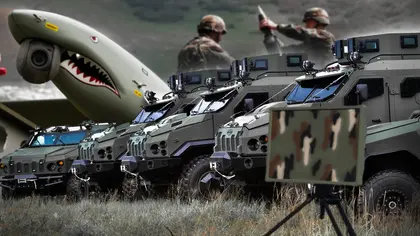Being the site of the largest European war since World War II has led to the rapid development of Ukrainians’ home-grown defense industry.
Privately owned factories are sprouting up across the country and taking over what had largely been strictly state-owned companies.
JOIN US ON TELEGRAM
Follow our coverage of the war on the @Kyivpost_official.
Private enterprises are often quicker and nimbler in a landscape where speed is, literally, a matter of life and death.
The leading private defense manufacturers have a trade organization — the National Association of Ukrainian Defense Industries (NAUDI).
Ukrainian arms manufacturers mostly produce armored vehicles, self-propelled howitzers, unmanned aerial vehicles (UAVs), radars, electronic warfare systems, various shells and mines, as well as surveillance, and guidance and reconnaissance systems.
This year, according to Forbes, which referenced high-ranking officials in the Defense Department, the enterprises are able to produce products worth about $15 billion – five times more than in 2023, and twice as much as was purchased.
That said, they only have one customer – the Ukrainian government. Since the beginning of the introduction of martial law, Kyiv has suspended any exports.
"This is quite a big problem for private enterprises,” Maksym Polyvyany, executive director of NAUDI, tells KyivPost.
“For example, an enterprise can produce products worth Hr.170-180 billion hryvnias ($4.25-4.5 billion) per year, while the [cash-strapped] state buys only 50 percent of what is produced for Hr.90 billion ($2.25 billion). Because of this, production is forced to be reduced due to a lack of funds for the payment of wages to employees and taxes. There is stagnation because profit does not allow us to create new types of weapons.”

Trump Makes 90 Day Foreign Aid Freeze – Ukraine Military Support Supposedly Untouched
And while Ukraine is very good at making certain kinds of weapons, like drones – it has problems producing other things, like certain kinds of ammunition for example, which it has to get abroad.
For that reason, the association of private producers is proposing the resumption of arms exports.
Though it may seem counterintuitive to export weapons when you need weapons at home, the association argues that through exporting Ukrainian weapons, manufacturers will be able to bring foreign dollars in, scale up and further improve the Ukrainian defense industry at home, and ultimately make better, cheaper weapons for Kyiv.
Competing with Russia
This year’s world defense show in Saudi Arabia was attended by Russian companies that were selling the kinds of weapons now being used at the front line in Ukraine.
“In particular, the Russians presented Orlan-10 unmanned [drone] systems. In other words, now is the time to present Ukrainian weaponry. It is effective and has been tested by war. We can market it based on this. Moreover, foreign investors are interested in the types of weapons we present,” Polyvyany said.
And fewer customers are inclined to buy weapons from Russia, which is being shunned both due to its unprovoked full-scale invasion of Ukraine and because it has been having trouble delivering on orders.
According to the published ranking of arms exporters by the Stockholm International Peace Research Institute (SIPRI), Russia recently lost its traditionally second-place position after the US, to France.
In 2019-2023, arms exports from Russia halved — by 53 percent. Its share in global military supplies decreased by 10 percent.
In 2019 Moscow supplied weapons to 31 states, then in 2022 — only to 14, and in 2023 — to 12. Ukrainian arms manufacturers argue they can take Russia’s place.
Trading arms Ukraine has, with those it does not
At the same time, according to SIPRI, perhaps not surprisingly, Ukraine is the top arms importer in Europe.
"There are doubts that our partners would understand why they’re providing us with military assistance, while at the same time, we’re selling our weapons,” Polyvyany said, however.
“Therefore, it is necessary to explain that Ukraine really needs their help, as it cannot produce in sufficient quantities or at all — aviation, artillery, long-range missiles, heavy equipment, etc.,” he said.
But other weapons, Ukrainian arms makers say, they can make quickly and abundantly, it’s just that the state’s limited budget stunts their growth.
“The fact that enterprises can produce several times more is stated not just by the manufacturers themselves, but also by the Ministry of Strategic Industries and the Ministry of Defense,” Serhiy Zhurets, the director of the Defense Express information and consulting agency, told KyivPost.
“At the same time, state orders are rather non-rhythmic — once every six months or a year. That is, enterprises can fulfill defense orders and export contracts without obstacles,” he said.
Zhurets said that most in Ukraine’s Ministry of Defense have no reservations about Ukrainian arms manufacturers exporting, but any initiative to do so would have to be carefully communicated with Kyiv’s allies.
“Export will make it possible to load enterprises [with orders] more regularly and develop them with the help of foreign countries. Also, the replenishment of the budget will make it possible to buy weapons in the West that we don’t have,” Zhurets said.
Ukrainian arms exports won’t create security problems
According to Zhurets, selling weapons abroad won’t create a security problem because the state has priority in all weapons orders.
“In addition, exports will be carried out only to friendly countries, the list of which is determined by the Ministry of Foreign Affairs and military intelligence,” Polyvyany said, adding that it’s mostly clear who is friendly to Ukraine and who isn’t based on votes in the UN.
This is the first of a two-part series.
You can also highlight the text and press Ctrl + Enter










